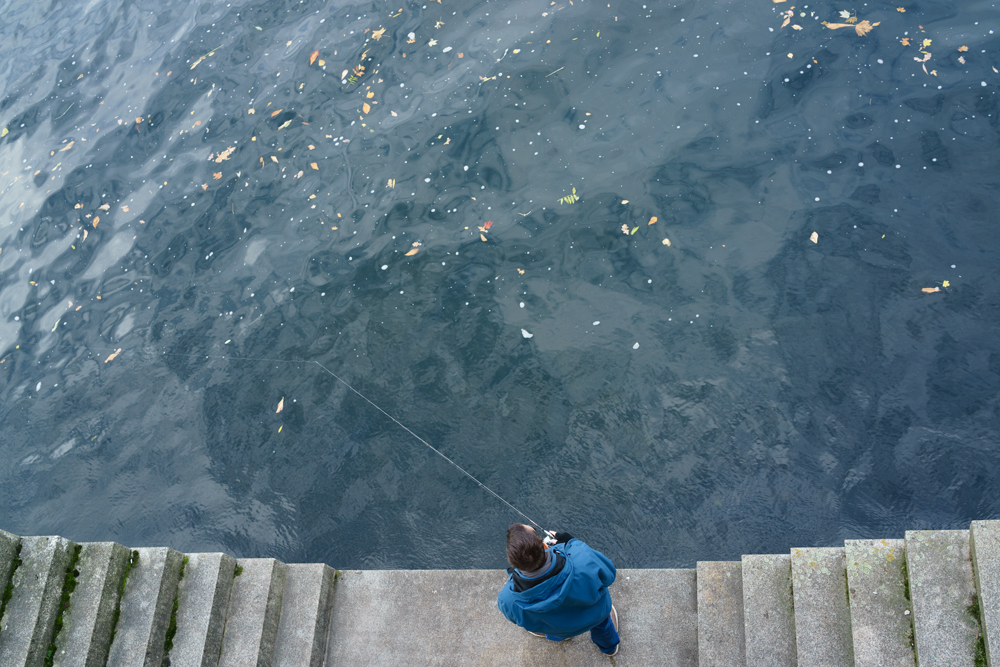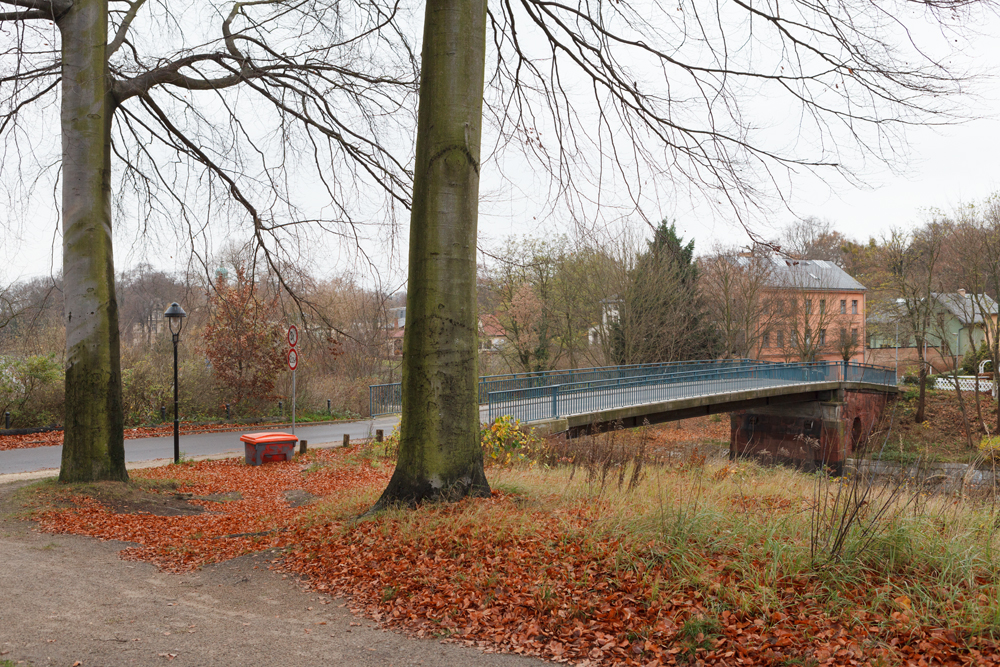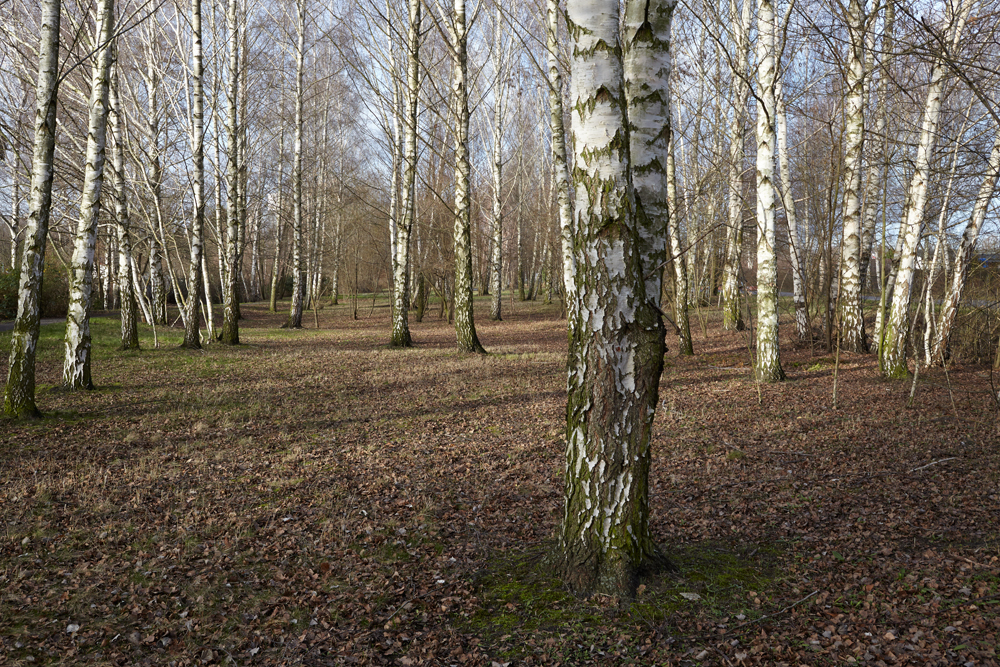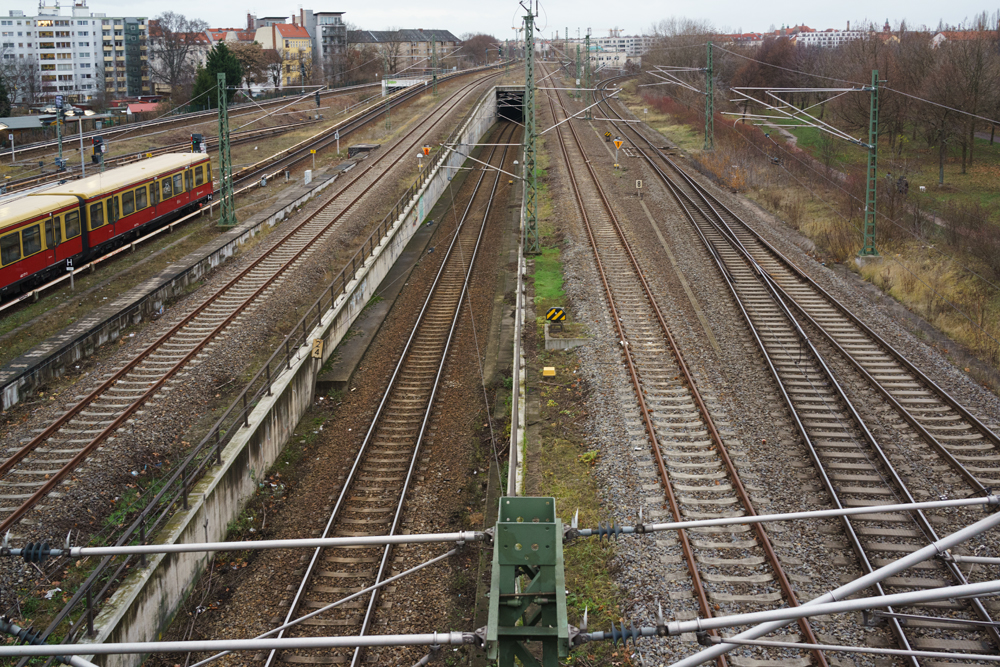Terri Warpinski: Death[s]trip
December 9, 1961 [Dieter Wohlfahrt]
Corner of Bergstrasse and Hauptstrasse, Staaken, 54 years later.
When the sector border permanently closed in August of 1961, 20-year-old Dieter Wohlfahrt used the privileges of his Austrian passport to help friends and classmates escape to West Berlin. On December 9, 1961, he was helping the mother of a friend to join her in West Berlin. After cutting through the three layers of barbed wire that marked the border here something alerted the border police to their presence. Before shots were fired Dieter dropped down, lying on the ground beneath the wire. He was hit just 5 meters from the border. He remained in place, motionless for over an hour while the East German guards threatened to shoot anyone who attempted to assist him before they carried his lifeless body away.
Photographer Terri Warpinski thinks a lot about these ever changing, fragile times in which we live, times that are filled with uncertainty and confusion. “Sometimes I want a photograph to be a statement and point at something pretty clearly. Other times, and perhaps a lot of the time, I want a photograph to be read the same way my ethnicity is. “What are you!?” I think that more accurately represents the world we live in. There are times when things are clear and straight to the point, and other times to be confused, uncertain, and lost.”
Her project, Death[s]trip, is a story of human mortality told through the landscape, focusing on enforced political borders between nations–an incredibly timely project with the newly elected administration speaking regularly about building walls and fences. In the exhibition, the text is a part of the imagery, but for today’s LENSCRATCH post, the text is shown independent of the photograph to facilitate easier reading. Each photograph was made on the date that coincides with the anniversary of the victim’s death, and cited in the exact location where the event took place. In total, between 1961-1989, 136 individuals died as a direct result of the Berlin Wall. The photographs here represent the 27 victims that died during the months of November and December.
Terri writes: For the past fifteen years my work as an artist has been driven largely by the conviction that borders are as much historical processes as they are physical facts — constructions that result from conscious human determination. A border is a decision, one with moral and mortal consequences; an act that reaches from the global arena of politics and economic power down to the intimate level of individual human lives.
My earliest explorations of Berlin caused me to consider the obvious and the hidden ways in which borderlands become memorial sites. Berlin pointed that out to me in retrospect and guided me towards understanding the same to be true of our contemporary borders.
At the end of the Cold War, the number of walled or fenced borders between nations/states dropped from the historical high of eighteen down to twelve, and it seemed possible to imagine that the world would soon be borderless, moving ever closer to a global society. The reality, however, is that since the fall of the Berlin Wall more than forty countries have built new fences separating them from more than sixty of their neighbors; more than thirty of these were built in the last fifteen years (following 9/11), with fifteen of them constructed in just the past year.
With the increased presence of border structures, there is a related increase in border associated mortality. The majority of those who die in this manner are never recovered or identified. How, then, can they be remembered?
Death[s]trip is a photographic project that seeks to restore memory through stories of human mortality, linked to the landscapes in which the deaths occurred. Focusing on the victims of the Berlin Wall, Death|s|trip probes the contingent character of meaning, memory, and reflection in relation to both landscape and the photographic image. The project serves to commemorate each of its subjects by photographing the location where they died on the anniversary date of their death, thereby not only celebrating their lives and remarking upon their loss, but drawing attention to the global crisis of border-related deaths. The stories these photographs reveal are striking in their detail, heartbreaking in the failures they depict, and disturbing in the resemblance they bear to deaths that continue to occur today, as innocent men, women, and children seek a life free of oppression and poverty.
November 26, 1965 [Lothar Lehmann]
The Havel River, 53 years later.
19-year-old Lothar Lehmann was among the many young people pressured through propaganda into serving in the GDR military as the Berlin Wall was being built. He also was among the great number of deserters who sought to escape in the first months of the wall’s existence. Assigned to serve in the border patrol’s boating unit, Lehmann attempted to reach the West by swimming across the Havel River wearing a life preserver. On November 26, 1962 he was found by border guards and pulled, unconscious, out of the river. He never regained consciousness.
November 27, 1962 [Otto Reck]
Corner of Invalidenstrasse and Gartenstrasse, 53 years later.
On November 27, 1962, fleeing from border soldiers after abandoning a plan to escape to West Berlin through a U-Bahn ventilation shaft with a friend, 17-year-old Otfried Reck was shot down and mortally wounded at the skating rink that once stood on this site.
November 4, 1963 [Klaus Schroter]
The Spree River alongside Marschall Brücke, 52 years later.
For thirty years Klaus Schröter’s death with formally attributed to a brain contusion. The facts were finally revealed in 1994 that on the morning of November 4, 1963 Klaus attempted to escape from East Berlin by an underwater route in homemade scuba gear. The East German border guards watched him descend a staircase below the Marschall Brücke after cutting through wire fencing and opened fire on him after he dropped into the water. He lost consciousness and drowned after a bullet grazed the back of his head.
November 19, 1962 [Horst Plischke]
Havel River North of Gleinecke Brücke, 53 years later.
In the early morning hours of November 19, 1962 Horst Plischke entered the water of the Havel River in an attempt to swim to the West Berlin shore. Upon being discovered, the border guards repeatedly fired at him. They conducted an intense search in the water and along the shoreline but were unable to locate him. On March 10, 1963 his body was found floating in the Jungfernsee. Neither the escape attempt nor the retrieval of his remains were ever publicly reported. The fact of Horst Plischke only came to light in 1994 when records were found in the offices of the East German border troops during the investigation of war crimes.
December 13, 1963 [Dieter Berger]
Near the Wrede Brücke along the Teltow Canal, 52 years later.
On December 13, 1963 Dieter Berger showed up for work as usual. He was laying brick for the new East Berlin Academy of Science. During his lunch break he and a co-worker drank heavily. Then, instead of returning to work, he walked away from the job site and into the border grounds in the neighboring district of Johannisthal. Two guards watched him enter the area. When he failed to heed their orders to halt, they shot him. No one who knew Dieter Berger believed he had any intention of escaping to West Berlin.
December 3, 1964 [Joachim Mehr]
German Youth Forest between Hohen Neuendorf and Bergefelde, 51 years later.
Shortly after midnight on December 3, 1964, after being gunned down and trapped in barbed wire, Joachim Mehr and a companion had already surrendered to East German soldiers when additional shots were fired at Joachim, killing him on the spot. His friend survived.
December 26, 1965 [Heinz Schoneberger]
The intersection of Sebastianstraße and Heinrich-Heine-Strasse, 50 years later.
Heinze Schöneberger and his brother Horst lived and worked in West Berlin. They often went to East Berlin, where they met up with Monika and Christel. The two women decided to escape to the West with the assistance of the brothers. After midnight on December 26, 1965 they all drove to the border crossing, lining up in the queue to exit with the two women hiding under the car’s bench seats. At the checkpoint Monika was discovered when the brothers were ordered out of the car. Heinz jumped back into the driver’s seat, locked the doors, and gunned the car towards the border in a futile attempt to break through the barriers. He came crashing to a halt, crawled out of the car and attempted to make a run for it. Just a few meters from safety he was hit in the back and died instantly.
November 15, 1968 [Horst Korner]
Lankestrasse near Babelsburg Park, 47 years later.
On the night of November 15, 1968 21-year-old Horst Körner, a member of the East German police force, was sent on temporary guard duty to Potsdam. Taking advantage of his position he slipped away unnoticed to make his way towards the West Berlin border along the Teltow Canal. Two East German border guards passing by the area in their vehicle noticed a man in uniform standing behind a tree. Körner, armed with his service weapon, opened fired on the vehicle killing the driver, Rolf Henniger. The other guard jumped out of the passenger seat firing repeatedly at Körner, killing him on the spot.
December 25, 1970 [Christian Peter Freise]
Köllnische Heide, Treptow, 45 years later.
On Christmas Eve, 1970, Christian Peter Friese rode a train 230 kilometers from Naumburg to East Berlin. He hid out in a small garden community along the perimeter of the border until midnight, then climbed over the interior fence. After triggering a trip wire, five guards posted on the elevated railway embankment responded, firing 98 rounds of ammunition at the fugitive. He collapsed and died in front of the last border fence with bullets lodged in his legs, stomach and chest.
December 31, 1971 [Horst Kullack]
Behind the Braunfelstraße between Lichtenrade and Brßziethen, 44 years later.
In 1967 Horst Kullack made his first escape attempt and was caught. After dark on December 31, 1971 he once again made his way from his home towards the border. After crossing an open expanse, he came upon a house and knocked on the window to inquire if he was passed the border. The occupant, a loyal Party member, alerted the authorities. Undeterred, Horst continued on to the security fence but was caught in the searchlights as the border guards searched him out. Without any further warning the two guards each fired two shots, hitting him in the stomach. Severely wounded, but not dead, he was pulled out of view into a trench and, later, was transported to a hospital where he eventually received medical attention. He died from his wounds on January 21, 1972.
November 22, 1980 [Marienetta Jirkowsky]
Florastrasse near Hohen Neuendorf, 35 years later.
On November 22, 1980 Marienetta Jirkowsky was fatally shot as she attempted to escape to West Berlin with her fiancé, Peter, and another friend. The shortest of the three, Marienetta was struck down by bullets as she was grasping for Peter’s hand to assist her over the final barrier. Peter fell from the top of the wall westward to safety.
December 12, 1981 [Thomas Taubmann]
Looking north over the train tracks from Böse Brücke, 34 years later.
Twenty-seven years after he died, Thomas Taubmann’s family first learned the details of his death. On December 12, 1981 Thomas hopped onto a freight train heading south out of Pankow into the city center of Berlin. As the train approached Bornholmer station, under the Böse Brücke, he jumped off. Failing to clear the Berlin Wall that bordered the tracks, he was, instead, struck and killed by the train from which he leapt.
December 1, 1984 [Michael Schmidt]
Behind Schultzestrasse No. 24, 31 years later.
In the early morning hours of December 1, 1984 Michael Schmidt snuck into a building on the sector border where he had been doing construction work. Using ladders he’d stowed away earlier, he climbed over a wall into a courtyard that was along the border control zone, and then climbed over the first barrier wall. He tripped an alarm as he was climbing over the signal fence. He managed to reach the final barrier wall with his ladder and grab hold of the top when he was shot down with strikes to his legs and back. Despite his pleas for help, the five soldiers involved did nothing more than cover him with a blanket. Hours later he was transported to a hospital where he was pronounced dead.
From her home base in Eugene, Oregon, artist/photographer Terri Warpinski travels the world in her creative practice focusing on the relationship between personal, cultural, and natural histories as revealed through the landscape.
A Professor of Art at the University of Oregon since 1984, Terri was distinguished as a Fulbright Scholar in Israel in 2000– 2001, and was a visiting professor at New Mexico State University in 2009. In 2014 she was awarded an Individual Artist Fellowship from the Oregon Art Commission, and in 2013 and 2016 Career Opportunity Grants through the Ford Family Foundation and Oregon Arts Commission.
Her work has been shown internationally in more than a hundred exhibitions, at such venues as the Pingyao International Festival of Photography in China; the U.S. Embassy in Jerusalem; Houston International Fotofest; the Center for Photography in Woodstock, New York; the University of the Arts in Philadelphia; and Camerawork in San Francisco. She has been awarded artist residencies at the Ucross Foundation in Wyoming, Playa in Oregon, Scuola Internazionale di Graphica in Venice, Annex:Art in Berlin, and Caldera in Oregon. Her border based landscape work was featured in the Spring 2014 issue of the Society for Photographic Education’s journal Exposure with an essay “Insecure Borders: Terri’s Warpinski’s Surface Tension” written by Katherine Ware, Curator, New Mexico Museum of Art. Surface Tension will be featured in the Australian landscape architecture Journal KERB in issue 24 (November 2016) focusing on the idea of ‘territory.’ A solo exhibition has been touring since the 2014 with venues in Colorado, Arizona, Oregon, Nebraska, Illinois, Ohio, Pennsylvania, and New York.
Posts on Lenscratch may not be reproduced without the permission of the Lenscratch staff and the photographer.
Recommended
-
Shinichiro Nagasawa: The Bonin IslandersApril 2nd, 2024
-
The International Women in Photo Association Awards: Lorraine Turci: The Resilience of the CrowMarch 16th, 2024
-
The International Women in Photo Association Awards: Rayito Flores Pelcastre: Chirping of CricketsMarch 14th, 2024
-
The International Women in Photo Association Awards: Louise Amelie: What Does Migration Mean for those who Stay BehindMarch 12th, 2024
-
Brandon Tauszik: Fifteen VaultsMarch 3rd, 2024










































































